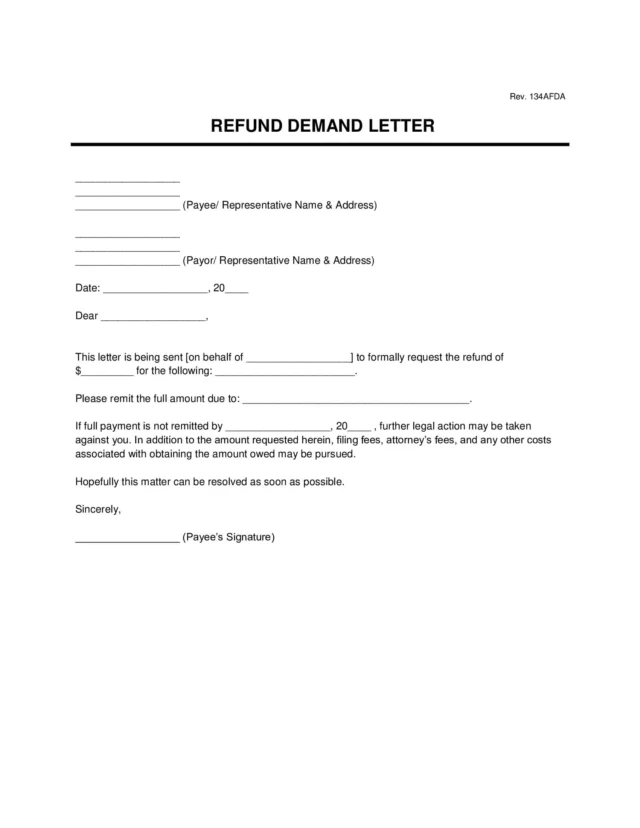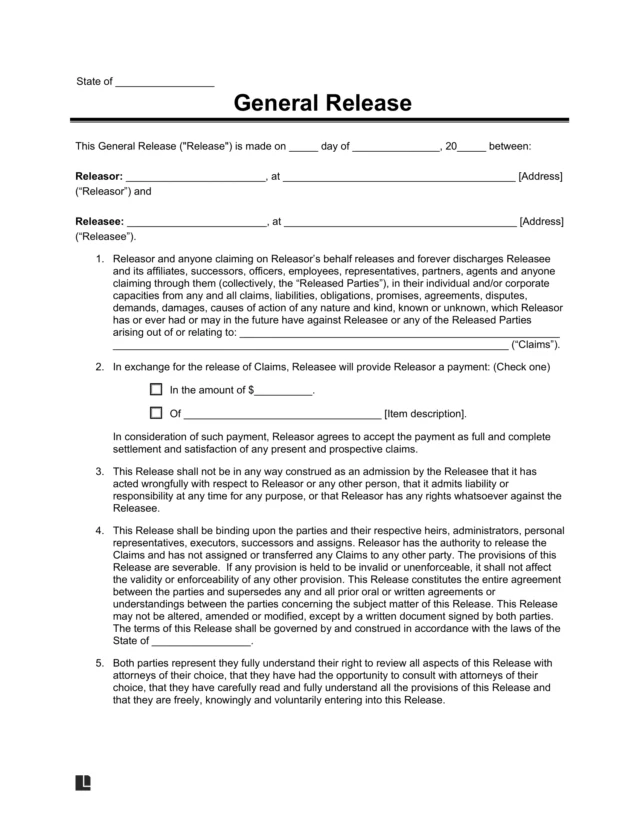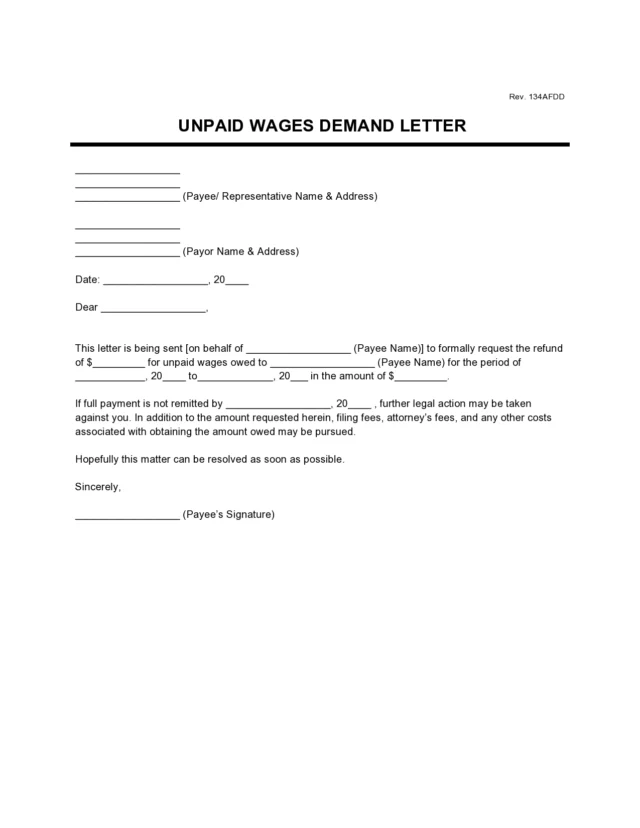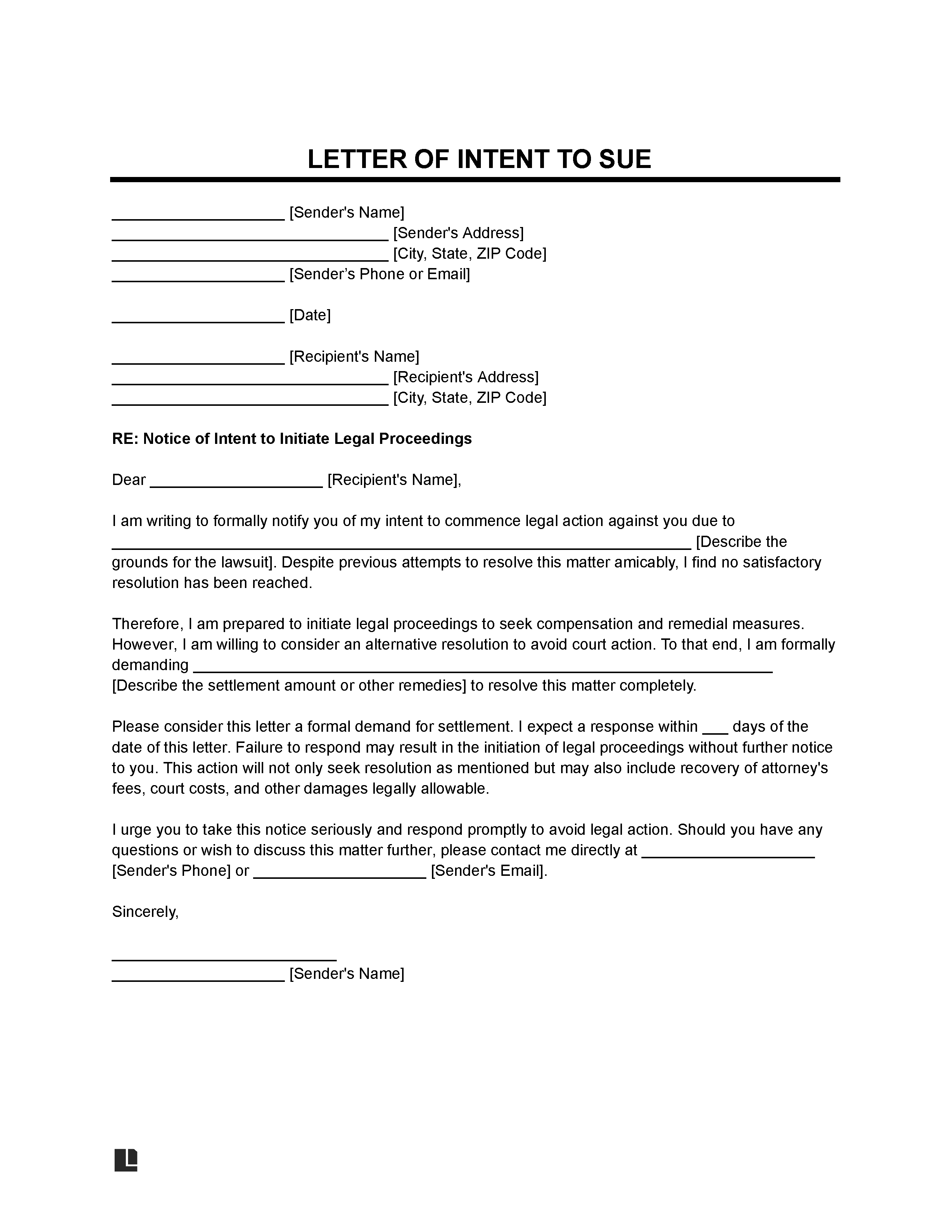What Is a Letter of Intent to Sue (With Settlement Demand)?
A letter of intent to sue (with settlement demand) is a notice a prospective plaintiff sends to a prospective defendant (the recipient) to inform them of their plan to sue. It tells the recipient that the sender is unhappy with the outcome of previous discussions regarding misconduct.
This pre-suit letter conveys the severity of the situation and outlines plans to sue. However, it also allows the defendant to settle by paying a demand. This option prevents the need for the sender to file a lawsuit, potentially saving both parties time and court expenses.
By writing this letter, you can clarify the nature of the dispute and organize your case’s details. It also allows you to communicate openly and reduce misunderstandings about your intentions.
What Is a Settlement Demand?
A settlement demand is a formal request from an afflicted party to a negligent or destructive party seeking a specific amount of compensation. It’s an attempt to resolve a legal issue without going to trial.
The demand explains the damage incurred, such as property damage or lost wages, and provides an amount the afflicted party believes will fairly compensate them for their losses.
When to Use a Letter of Intent to Sue (With Settlement Demand)
Here are some instances when using a letter of intent to sue (with settlement demand) can be beneficial:
- Debt Collection: You may send an intent to sue letter if you issued a demand for payment letter and have not received an adequate response.
- Property Disputes: You may want to resolve a property damage claim or a landlord-tenant dispute via a settlement before initiating legal proceedings.
- Incomplete Work: You may attempt to settle with an independent contractor who didn’t finish a project or completed unsatisfactory work.
- Personal Injury Claims: The injured party may send a settlement demand to the at-fault party or their insurer, allowing them to resolve the claim before filing a lawsuit.
Is a Letter of Intent to Sue Required?
A letter of intent to sue (with a settlement demand) may be required in some cases. For example, a court may require you to send a settlement demand letter before pursuing a lawsuit that pertains to cases involving:
- Claims against governmental authorities
- Complaints against health or auto insurance companies
- The violation of consumer protection statutes
- Medical malpractice claims
- Breach of contract claims
- Agreements that include a requirement for a demand letter if a dispute arises
Even in other cases where a letter of intent to sue isn’t required, it’s strongly recommended to facilitate a smooth resolution of a legal issue.
How to Write a Letter of Intent to Sue (With a Settlement Demand)
A letter of intent to sue can help you get compensation for a problem without going to court. When the letter is clear and concise, it can encourage the other party to take you seriously and settle the issue. Follow these steps to write a letter of intent to sue with a settlement demand.
Step 1 – Write the Header
Write the header for your pre-suit letter, including your name, address, and contact information in the first block. Insert the date you’re writing the letter on a new line.
In a new block below the date, insert the recipient’s name, address, and contact information. This way, you can identify both parties and state to whom the letter is addressed.
Step 2 – Compose the Introduction
Compose the introduction with a short salutation. A simple “Dear Recipient’s Name” will work well. Follow it with a brief statement that declares your intent to sue if the recipient doesn’t address the issue via a settlement. You may reference previous attempts to settle the matter, noting that there was no satisfactory result.
Step 3 – Provide Background Details
Provide background information on why you’re suing or seeking a settlement demand. Give a detailed description of the recipient’s wrongdoings and present supporting evidence. For example, if it’s a breach of contract, you can provide a copy of the original contract and a description of how the recipient failed to fulfill their end of the deal.
Step 4 – State the Settlement Terms
Your settlement demand letter should list the amount you’re willing to settle the situation for. Provide any other provisions the defendant must follow for you not to sue.
Clearly state a date by which the recipient must comply. For added clarity, you can provide a timeframe (such as 30 days) and an exact date by which you expect to receive the proposed amount.
Step 5 – Include a Legal Action Statement
State that you will take the case to small claims court or pursue another type of legal recourse if the recipient doesn’t comply with your settlement demand.
Step 6 – Write a Closing Statement
Conclude your letter stating that you’d like to resolve the situation privately via a settlement before filing a suit becomes necessary. A concise conclusion may help you achieve mutual agreement with the other party, preventing the need for a costly lawsuit.
Letter of Intent to Sue Example
Here’s an example of a letter of intent to sue (with a settlement demand) from a car accident victim to the perpetrator’s insurance company:
Jordan Blake
Providence, RI 02902
[email protected]
December 1, 2025
Clearview Insurance Company
Attn: Claims Department
Providence, RI 02902
[email protected]
Dear Claims Department,
I am writing to formally notify you of my intent to commence legal action against you due to Clearview Insurance Company’s failure to pay the remaining $40,000 owed for Claim Number 897724 arising from the October 15, 2025, car accident caused by your insured, Marcus Perry. Despite previous attempts to resolve this matter amicably, I find no satisfactory resolution has been reached.
Therefore, I am prepared to initiate legal proceedings to seek compensation and remedial measures. However, I am willing to consider an alternative resolution to avoid court action. To that end, I am formally demanding payment of the full outstanding amount of $40,000, which includes medical expenses, vehicle repair costs, and additional damages, to resolve this matter completely.
Please consider this letter a formal demand for settlement. I expect a response within 30 days of the date of this letter. Failure to respond may result in the initiation of legal proceedings without further notice to you. This action will not only seek resolution as mentioned but may also include recovery of attorney’s fees, court costs, and other damages legally allowable.
I urge you to take this notice seriously and respond promptly to avoid legal action. Should you have any questions or wish to discuss this matter further, please contact me directly at [email protected]
Sincerely,
Jordan Blake
[email protected]
Sample Letter of Intent to Sue (With Settlement Demand) Template
View a blank notice of intention to sue below to get an idea of how to write your own. Then, use our step-by-step questionnaire to fill in your details and create your own. When you’re done, you’ll be able to download a copy in PDF or Word format or print it out for distribution.
How to Send a Letter of Intent to Sue
While there’s no official protocol for sending a letter of intent to sue, it’s best to deliver it via certified mail. This way, you can prove that the recipient actually received the letter. A receipt of delivery may also become useful as evidence later if the court sees that you attempted to obtain a settlement first before pursuing legal action.
Alternatively, you may post the letter on the recipient’s property or send it via email, but these methods carry more risk, as the recipient may not be guaranteed to receive it.
Whatever method you choose, keep a copy for your records. You should also consider having an attorney review it to ensure the settlement demand is fair and reasonable.
What If My Letter of Intent to Sue Is Ignored?
If the recipient ignores your intention to sue letter or responds with a refusal to comply, you can send a follow-up letter. If they still don’t refuse to pay the settlement, you should discuss the situation with a lawyer and consider filing a lawsuit. Before filing, make sure you have sufficient grounds and evidence, as you must be able to demonstrate their initial wrongdoing.








